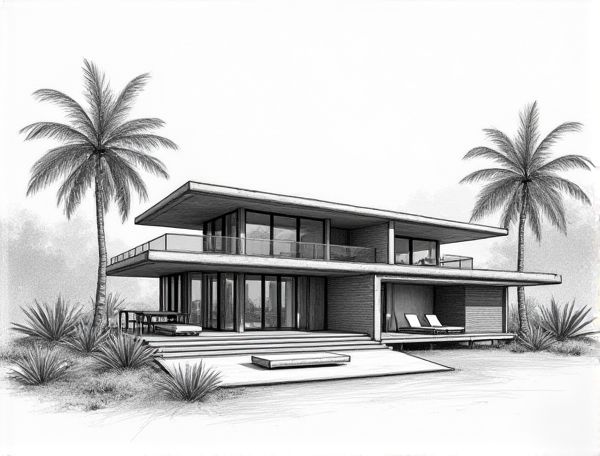
Photo illustration: Tropical modernist home design with deep overhangs
Tropical modernist home design with deep overhangs blends sleek, minimalist architecture with practical shading solutions to protect your interiors from intense sun and heavy rain, enhancing energy efficiency and comfort. Discover how these design elements create harmonious indoor-outdoor living spaces by reading more in the article.
Introduction to Tropical Modernist Home Design
Tropical Modernist Home Design blends clean, minimalist lines with natural materials and open spaces to create a seamless indoor-outdoor living experience tailored for warm, humid climates. Your home can benefit from features like large windows, shaded patios, and sustainable ventilation that enhance comfort while embracing the surrounding tropical environment.
Key Principles of Tropical Modernism
Tropical Modernism integrates natural ventilation, sustainable materials, and indoor-outdoor living to create comfortable, eco-friendly homes in warm climates. You benefit from large overhangs, cross breezes, and shading devices that reduce heat gain while enhancing natural light. Prioritizing local resources and climate-responsive design, this style ensures energy efficiency and a harmonious connection with the environment.
The Role of Deep Overhangs in Tropical Architecture
Deep overhangs in tropical architecture provide essential shade, reducing direct solar heat gain and enhancing indoor comfort in hot, humid climates. These extended roof projections protect your home's walls and windows from heavy rain, minimizing moisture damage and prolonging structural durability. Incorporating deep overhangs optimizes natural ventilation and light management, contributing to energy-efficient and sustainable tropical home design.
Climate Responsiveness: Passive Cooling and Shading
Incorporating climate responsiveness through passive cooling techniques such as strategic window placement and natural ventilation reduces reliance on mechanical systems, enhancing energy efficiency. Effective shading devices like overhangs, louvers, and vegetation minimize solar heat gain, maintaining indoor thermal comfort while lowering cooling costs.
Integrating Natural Materials and Local Textures
Integrating natural materials like reclaimed wood, stone, and bamboo enhances home design by fostering a warm, organic aesthetic that promotes sustainability. Employing local textures such as regional textiles, handcrafted ceramics, and native stonework supports cultural authenticity and reduces environmental impact. Combining these elements creates a harmonious, eco-friendly living space that reflects the unique character of its surroundings.
Open-Plan Layouts for Tropical Living
Open-plan layouts enhance tropical living by maximizing natural airflow and sunlight, creating a seamless connection between indoor and outdoor spaces. This design approach uses wide sliding doors and strategically placed windows to promote ventilation and reduce reliance on artificial cooling. Your home benefits from an airy, spacious atmosphere that harmonizes with the vibrant tropical environment.
Seamless Indoor-Outdoor Transitions
Create seamless indoor-outdoor transitions by incorporating large sliding glass doors that maximize natural light and provide unobstructed views of your garden. Use consistent flooring materials between indoor living spaces and outdoor patios to enhance visual continuity and flow. Your home will benefit from a harmonious blend of interior comfort and outdoor ambiance, perfect for entertaining or relaxation.
Sustainable Practices in Tropical Modernist Homes
Sustainable practices in tropical modernist homes emphasize passive cooling techniques such as cross-ventilation, large overhangs, and strategically placed shading devices to reduce reliance on mechanical air conditioning. The use of locally sourced, renewable materials like bamboo and reclaimed wood enhances environmental responsibility while blending seamlessly with natural surroundings. Incorporating rainwater harvesting systems and solar panels further minimizes ecological footprints and promotes energy efficiency in tropical modernist residential designs.
Landscaping and Lush Greenery for Cooling
Incorporating lush greenery and strategic landscaping enhances natural cooling by reducing heat absorption with dense foliage and shade-providing trees. Your outdoor space benefits from lower temperatures and improved air quality, creating a comfortable and eco-friendly environment.
Iconic Examples of Tropical Modernist Homes
Tropical modernist homes showcase seamless integration of indoor and outdoor living spaces, using natural materials like bamboo, teak, and stone to enhance environmental harmony. Iconic examples such as Geoffrey Bawa's Kandalama Hotel in Sri Lanka and Lina Bo Bardi's Glass House in Brazil demonstrate innovative designs that optimize ventilation, natural light, and sustainable cooling methods. Your home design can draw inspiration from these masterpieces to create a functional, stylish, and eco-friendly tropical retreat.
 homedesy.com
homedesy.com